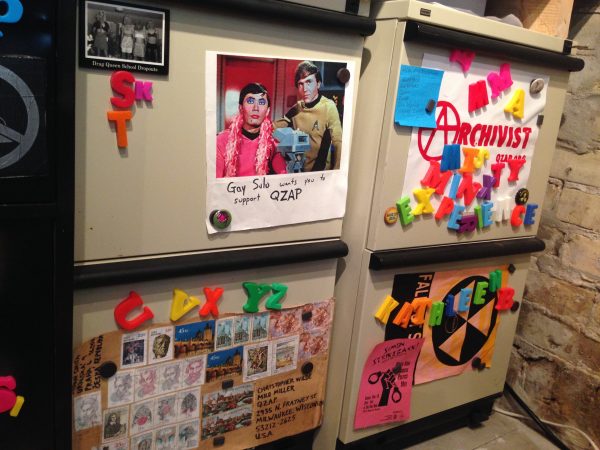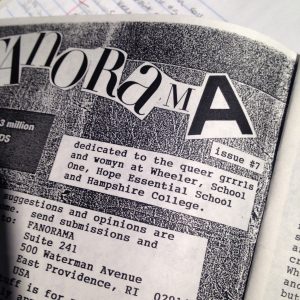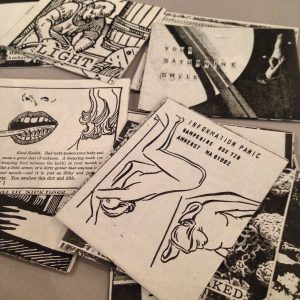Finding Hampshire at the Queer Zine Archive Project
This is the first of two posts by CSI Librarian Alana Kumbier, reporting on her summer research residency at the Queer Zine Archive Project.
When my friends ask what I did during my residency at the Queer Zine Archive Project this month, I tell them that I spent the week reading lesbian sex zines from the 1990s. Which is pretty much true. And I’ll write more about that in a second post. But first, some context: a couple of weeks ago, I completed a research residency at the Queer Zine Archive Project, or QZAP. QZAP’s mission is to “establish a ‘living history’ archive of past and present queer zines and to encourage current and emerging zine publishers to continue to create.” Most of QZAP’s collection is freely-accessible for reading online & downloading, through the website at qzap.org. If you identify as queer, and you make a zine, you can send it to QZAP & they’ll archive it.
Last winter, QZAP’s co-founders, Milo Miller and Chris Wilde, invited me to participate in the Project’s summer residency program. QZAP Residents are given the opportunity to come and visit the archive for a span of 7-10 days during the summer. The archive is in the basement of Chris & Milo’s house, and residents get to sleep in the same space as the zines, have 24/7 access to the collection, and share dinners with their hosts. My friend Dianne Laguerta and I coordinated schedules and did our week-long residencies at the same time, which meant that we could compare notes, share great finds from the files, and take lunches and walks around the neighborhood together when we needed a break from reading. During our residency, Milo and Chris also ensured that we had plenty of fun times: a day trip to Madison, eating fried cheese curds and fried pickles, watched a bunch of restored episodes of Daria, and having a Clea DuVall appreciation night featuring a screening of But I’m a Cheerleader (in a completely related turn of events, Dianne & Milo are compiling a Clea DuVall fanzine).
Over the past couple of summers, I’ve made trips to research zines in conventional academic libraries and archives, and in those spaces, researchers are expected to do certain things: email ahead of time to let the archivist know they plan to visit, present an ID when signing into the archive, ask a staff member to pull a specific box or set of boxes from storage, look at zines one folder at a time, and do not bring beverages, food, or ink anywhere near the materials. It’s different at QZAP, where researchers (once they get into the space) have unrestricted access to the zines in the file cabinets.

Because of this, researchers don’t have to know what they’re looking for when they enter the archive, and can look at everything in the file cabinets. Dianne and I spent a lot of time browsing through the files at the start of our residency, looking at zines that caught our attention, and getting familiar with the collection (organized alphabetically by title) and its sub-collections (organized by original collector, in alignment with the archival principle of provenance). Approaching the collection this way, researching and reading without a plan — just for pleasure! — was a weird experience for me. I had to keep reminding myself that the experience of exploring the collection, of letting my days unfold without goals, was important in itself. I appreciated that it was impossible to know what work the zines could do for me: I couldn’t predict what questions they might elicit or what analyses they might enable. I also knew that a week wasn’t enough time to go from my first reading of the non-digitized zines to some sort of analysis, especially since I’m just at the start of some new research projects. I did my best to stay present in the experience of just reading the zines and thinking about them, and resisted the urge to copy or scan entire zines.
I knew I’d be writing about my residency for the library blog when I returned to work. With this post in mind, I was on the lookout for zines by Hampshire students, or connected to Hampshire in some way. Here’s what I found. To the best of my knowledge, these are all zines from the early 1990s:
Girl Fiend #4 by Cookie Tuff / Christina: This issue is about negotiating queer identity, punk scenes, going to a riot grrrl meeting & tensions of identifying with ‘riot grrrl’ as a category, coming out, friendships between girls, classes & class projects, connecting with other girls through zines, and raising the question of how to be queer, which many queer girls in the 1990s (including me) were trying to answer in the absence of role models/community/the Internet.
QuART #3 by Collin: In this issue of ‘QuART’ (an acronym for “Queers And Related Terrorists”), Collin takes up the call for queers to “bash back” against abuse at the hands of queer-bashers. They write about a queer riot at the Rhode Island state house following the veto of a gay rights bill, and celebrates feminist drag and ‘girlie’ presentation.
 Fanorama #7, the Queer Grrrl issue, while not made by a Hampshire student, features shout-outs to the “queer grrrls and womyn” and the “bisexual womyn” at Hampshire College. It was created by REB, who was living in Providence, RI at the time, and, as we learn from the publisher’s note, was dating someone named Collin (possibly the same Collin who authored Quart? Gossip in the archives!).
Fanorama #7, the Queer Grrrl issue, while not made by a Hampshire student, features shout-outs to the “queer grrrls and womyn” and the “bisexual womyn” at Hampshire College. It was created by REB, who was living in Providence, RI at the time, and, as we learn from the publisher’s note, was dating someone named Collin (possibly the same Collin who authored Quart? Gossip in the archives!).
Finally, my favorite Hampshire-related find was a trove of mini-zines that had made their way into the Lane McKiernan collection at QZAP. These zines aren’t digitized, and their return addresses identify their author/editors as Information Panic.
 I was most drawn in by two issues: one was themed around lighthouses, the other told a great story about a group of roommates who are in dire need of toothpaste, and experience collective joy when someone presents a new tube to the group, and everyone brushes their teeth in celebration. Both issues conjured images and presented compelling mysteries, like: who made them? Was Information Panic the title of the zine, the name of its creator(s), or something else? And how did they get into Lane’s collection, in Minneapolis?
I was most drawn in by two issues: one was themed around lighthouses, the other told a great story about a group of roommates who are in dire need of toothpaste, and experience collective joy when someone presents a new tube to the group, and everyone brushes their teeth in celebration. Both issues conjured images and presented compelling mysteries, like: who made them? Was Information Panic the title of the zine, the name of its creator(s), or something else? And how did they get into Lane’s collection, in Minneapolis?
These questions were just a few that emerged during my week at QZAP. In my next post, I’ll write about the questions that arose when I started looking at those lesbian and bisexual sex zines from the 1990s.
